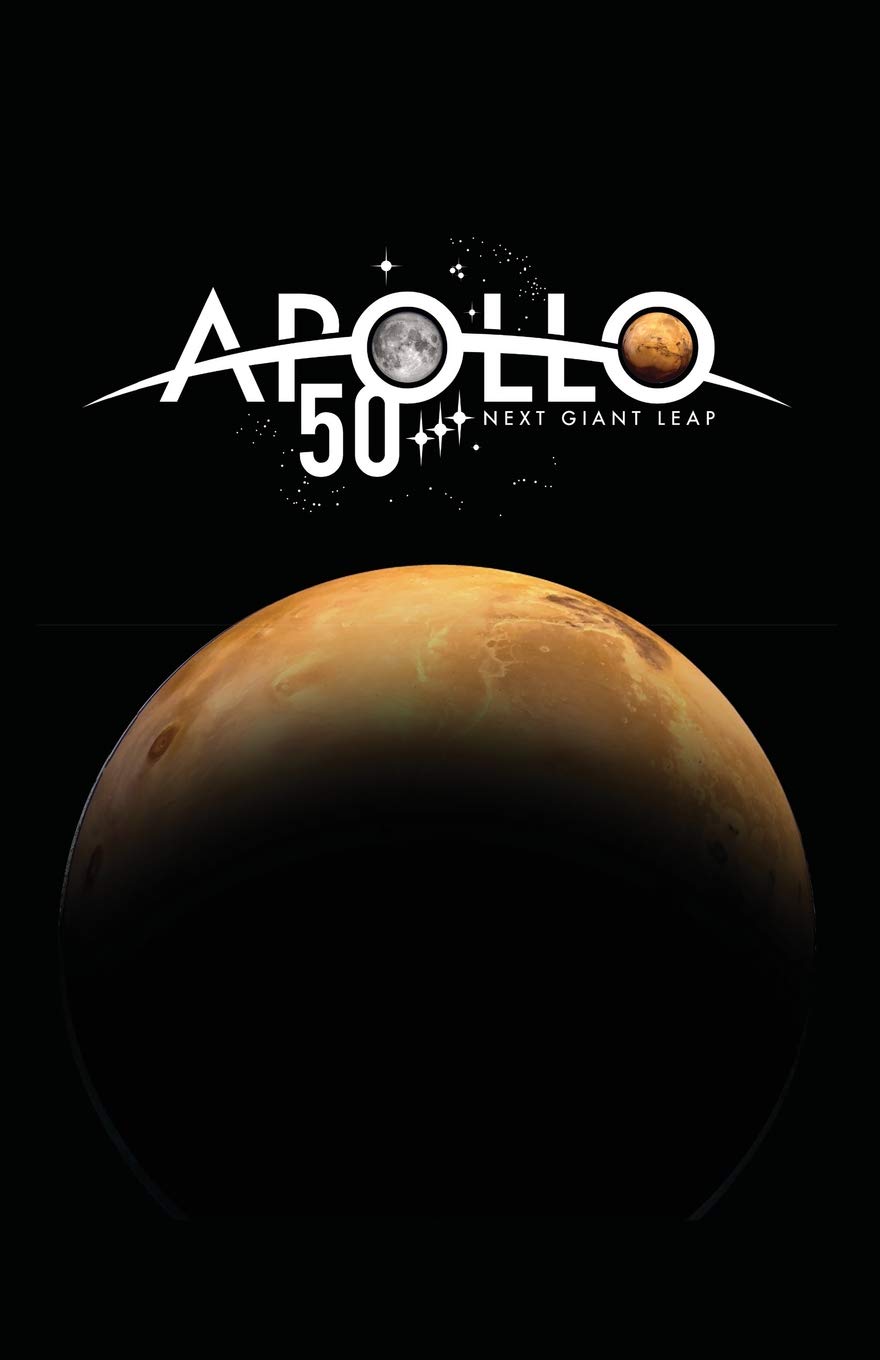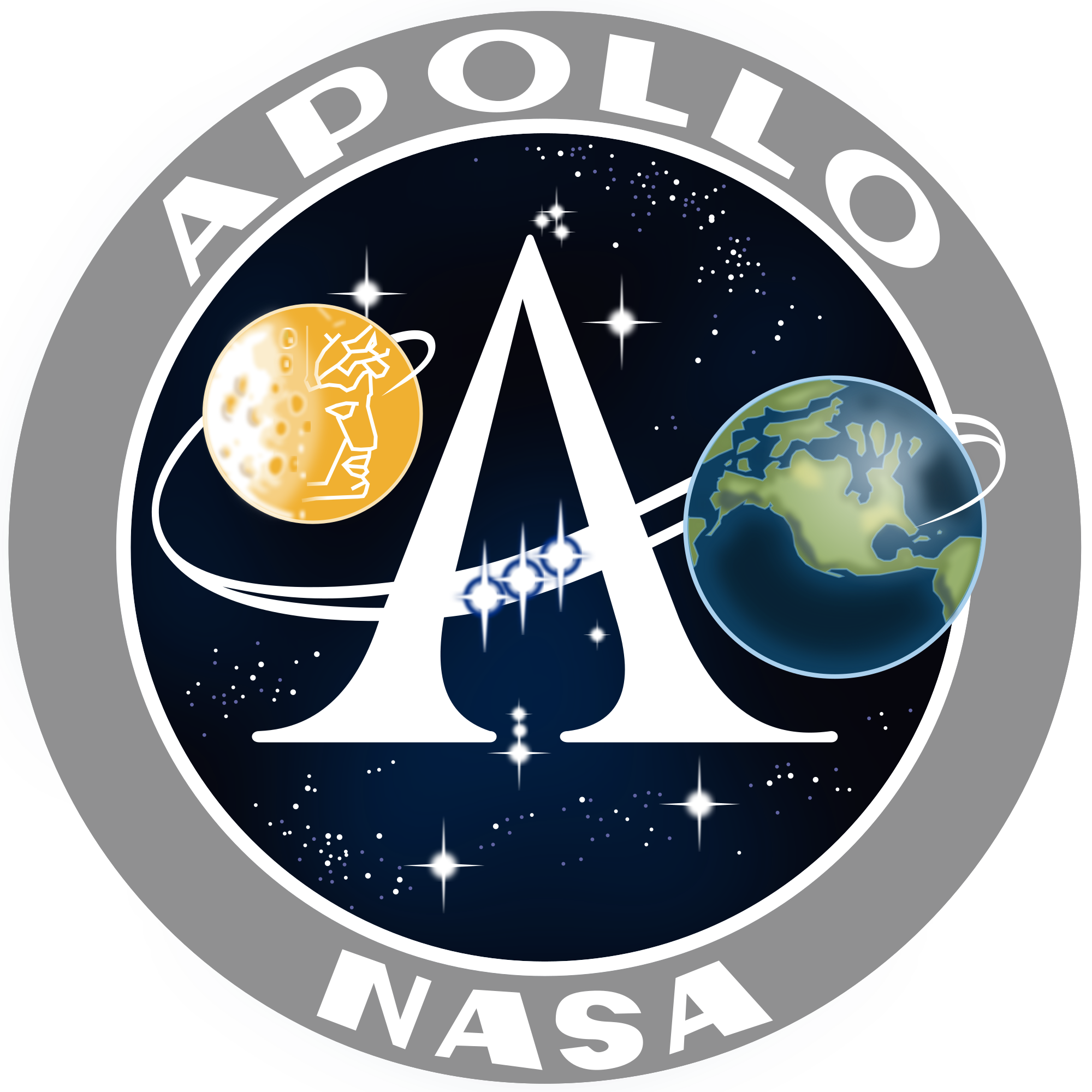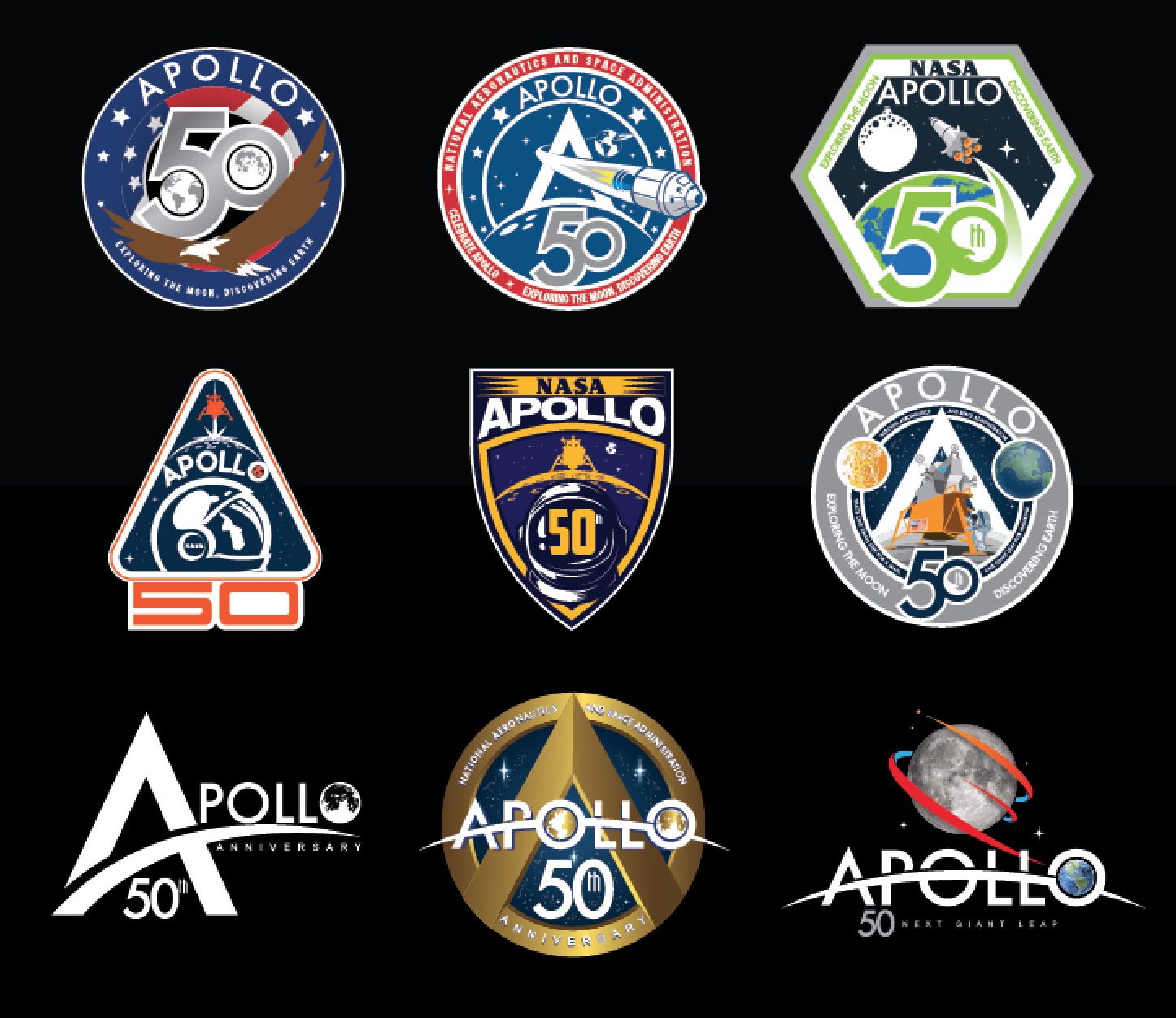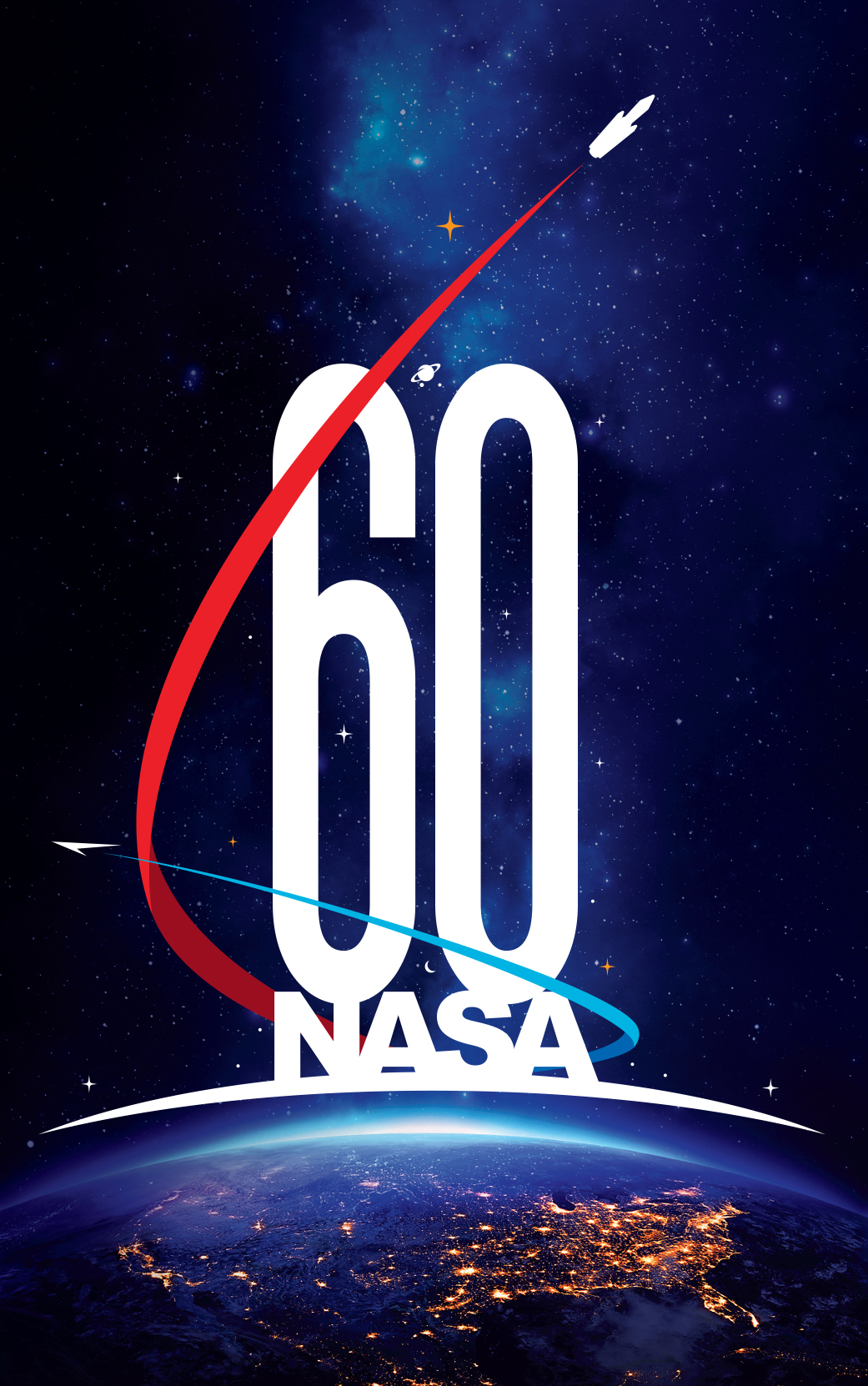NASA celebrates its space odyssey milestones with two logos and beyond
NASA is celebrating the very start of its humble beginnings. From October 2018 through December 2022, NASA will mark the 50th anniversary of the Apollo Program that landed a dozen Americans on the moon between July 1969 and December 1972. To celebrate these milestones anniversaries NASA unveiled an official logo for use in at the Kennedy Center for the Performing Arts in Washington.
Created by NASA graphic artist Matthew Skeins, the logo offers a nod to the past with a few elements borrowed from the original program emblem and a glimpse into the future with a graphic depiction of NASA’s vision for the next half-century of deep space exploration.
The arc through the word “Apollo” represents Earth’s limb, or horizon, as seen from a spacecraft. It serves as a reminder of how the first views of Earth from the Moon transformed the way we see ourselves as human beings. It also affirms NASA’s intention to continue pushing the boundaries of knowledge.
 The original Apollo emblem, adopted by the program in 1965, used drawings of the Moon and Earth linked by a double trajectory to portray President John F. Kennedy’s goal of "putting a man on the moon and returning him safely to the earth" by the end of the 1960s.
The original Apollo emblem, adopted by the program in 1965, used drawings of the Moon and Earth linked by a double trajectory to portray President John F. Kennedy’s goal of "putting a man on the moon and returning him safely to the earth" by the end of the 1960s.
The original emblem was a composite design derived from the ideas of NASA employees and contractor personnel. It featured the constellation Orion overlaid on a capital letter "A." The constellation was positioned so that its three central stars formed the bar in the initial for "Apollo".
In similar fashion, the Apollo 50th anniversary logo describes a contemporary goal, with images of the Moon and Mars filling the first and second "O"s, respectively, and the phrase "Next Giant Leap" beneath the word "Apollo." Neil Armstrong declared his first step onto the lunar surface from the ladder of the Eagle lander on July 20, 1969, to be "one small step for a man, one giant leap for mankind."
The original emblem was a composite design derived from the ideas of NASA employees and contractor personnel. It featured the constellation Orion overlaid on a capital letter "A." The constellation was positioned so that its three central stars formed the bar in the initial for "Apollo".

In the 50th anniversary logo, elements of the same star field recall the collective effort of some 400,000 people who worked on the Apollo Program – an 11-year series of 33 spaceflights including six that reached the lunar surface.
The three central stars are repositioned diagonally beside “50” to emphasize the many sacrifices made in pursuit of the lunar goal - especially the lives of Apollo 1 astronauts Virgil "Gus" Grissom, Ed White and Roger Chaffee who perished in a capsule fire during a test on the launch pad in January 1967. The star field, like the rest of the anniversary logo, is set against a blue nebula as an acknowledgement that human footprints on distant worlds is not too big a dream, and confirmation that NASA already is working toward that goal.
 The unveiling of this logo was part of "NSO Pops: Space, the Next Frontier," a National Symphony Orchestra celebration of NASA’s 60 years of accomplishment as 2018 marked the administration's 60th anniversary since its establishment as a U.S. government agency. President Dwight D. Eisenhower signed NASA’s founding legislation, the 1958 National Aeronautics and Space Act, on July 29, 1958. NASA considers its birthday to be Oct. 1, the day the agency opened for business.
The unveiling of this logo was part of "NSO Pops: Space, the Next Frontier," a National Symphony Orchestra celebration of NASA’s 60 years of accomplishment as 2018 marked the administration's 60th anniversary since its establishment as a U.S. government agency. President Dwight D. Eisenhower signed NASA’s founding legislation, the 1958 National Aeronautics and Space Act, on July 29, 1958. NASA considers its birthday to be Oct. 1, the day the agency opened for business.
In pure NASA tradition, the National Aeronautics and Space Administration has released an official logo for use in observing this milestone anniversary. Created once again by Skeins, the logo depicts how "NASA is building on its historic past to soar toward a challenging and inspiring future."
 NASA and 60 are stacked, bold and tall, atop the continental United States, the curvature of Earth, and the light of the approaching dawn. This placement captures the spirit of a metaphor about knowledge and discovery, often attributed to 17th-century physicist Isaac Newton: 'If I have seen further than others, it is by standing on the shoulders of giants.' Similarly, NASA was built from the legacy and expertise of giants in government-sponsored research and development, including the National Advisory Committee for Aeronautics (NACA), the Naval Research Laboratory, the Army Ballistic Missile Agency, and the Jet Propulsion Laboratory. The United States is shown at night beneath a sparkling web of yellow lights.
NASA and 60 are stacked, bold and tall, atop the continental United States, the curvature of Earth, and the light of the approaching dawn. This placement captures the spirit of a metaphor about knowledge and discovery, often attributed to 17th-century physicist Isaac Newton: 'If I have seen further than others, it is by standing on the shoulders of giants.' Similarly, NASA was built from the legacy and expertise of giants in government-sponsored research and development, including the National Advisory Committee for Aeronautics (NACA), the Naval Research Laboratory, the Army Ballistic Missile Agency, and the Jet Propulsion Laboratory. The United States is shown at night beneath a sparkling web of yellow lights.
This symbolizes NASA’s vibrancy and relevance, the inspiration derived from NASA’s work, and the solid foundation of the "best and brightest" among industry and academia upon the agency’s leadership in space is built. The light blue and white arc just below the alphanumeric elements recalls the sunrise, seen 16 times each day aboard an Earth-orbiting spacecraft, and symbolizes opportunity yet to come through exploration of the Moon, Mars and destinations far beyond.
NASA and 60 are stacked, bold and tall, atop the continental United States, the curvature of Earth, and the light of the approaching dawn. This placement captures the spirit of a metaphor about knowledge and discovery, often attributed to 17th-century physicist Isaac Newton: 'If I have seen further than others, it is by standing on the shoulders of giants.'
Two vectors, one blue and one red, circle the alphanumeric elements and point toward the dark outer edges of the logo as if zooming into the unknown. In doing so, they form a "6," which is emblematic of the number of decades since NASA was established. The blue vector represents NASA’s roots in aeronautics research and the societal impact of our first views of Earth as a solitary "blue marble" in the vast blackness of space. The red vector represents NASA’s leadership of an innovative and sustainable exploration program. Depicted at the tip of this vector are the key elements of NASA’s deep space transportation system, the Space Launch System rocket and Orion crew vehicle. A crescent moon, a ringed planet and a field of stars amid a nebula of light blue represent NASA’s scientific underpinnings, particularly the enduring quest for answers to age-old questions about the workings and evolution of our planet, our solar system and the universe.
The Apollo 50th anniversary logo is available for download from the NASA Images and Video Library.
Explore NASA's adventures now and beyond here.
Tags/ inspiration, illustration, posters, nasa, branding, anniversary, vector, usa, space, arc, apollo, john fitzerald kennedy, richard nixon




















